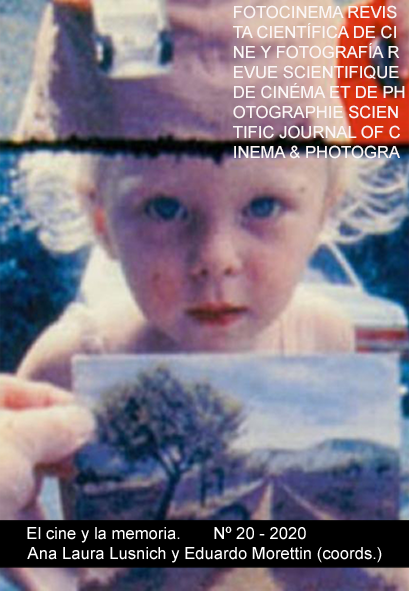Crisis in Lucrecia Martel's World
DOI:
https://doi.org/10.24310/Fotocinema.2020.v0i20.7620Keywords:
Analyse, Lucrecia Martel, Crisis, Heterotopy, CronographyAbstract
In the study we analyze three Lucrecia Martel films under the aegis of notions such as crisis, heterotopy and chronography. In addition we try to describe some hegemonic figures, such as the ellipse, in order to deal with the author style. The results point at that Lucrecia Martel delay the meaning in favor of a powerful sense which blooming in the end of the films. We meant, Martel make up some rethorical figures (heterotopia, chronography, and ellipse) in order to generate text effect very close, above all, to a crisis situation, an increased point of view during the films fruition. Our approach elucidate some films fragments, the ones that under the aegis of another point of view could impoverish the fruition. Therefore, we prefer to set up a brief rethoric study of Argentinian director in order to a better fruition.
Downloads
Metrics
References
Albano, S. G. (2016). A mão e a luva: os festivais como dispositivos para o world cinema. Mídia e cotidiano, 9 (9), 1-20. http://www.ppgmidiaecotidiano.uff.br https://doi.org/10.22409/ppgmc.v9i9.9787
Andrew, D. (2010). Time Zones and Jetlag. The flows and phases of World Cinema. En Durovicova, N. & Newman, K. (Eds.). World Cinemas, Transnational Perspectives (pp. 59-89). Nova York; Londres: Routledge.
Beristáin, H. (1997). Diccionario de retórica y poética. 8 edición. México: Porrúa.
Bhabha, H. K. (1998). O local da cultura (trad. Myriam Ávila et altri). Belo Horizonte: Universidade Federal de Minas Gerais.
Foucault, M. (2009). Outros espaços. Em Motta, M. de B. Estética: Literatura e pintura, música e cinema (pp. 437-445). 2 edição (trad. de Inês Autran Dourado da Motta). Rio de Janeiro: Forense.
Silva, B., Neto, A. G. M. & Veiga, José J. (1986). Dicionário de Ciências Sociais. Rio de Janeiro: Fundação Getúlio Vargas.
Page, J. (2013). Folktales and Fabulations in Lucrecia Martel's Films. En Geoffrey, K. & O' Brian, R. (Ed.). Latin America Popular Culture. Media, politics, affects (pp. 71-88) Suffolk, Grã Bretanha: Tamesis.
Rangil, V. (Ed.). (2007). El cine argentino hoy: entre el arte y la política. Buenos Aires: Biblos.
Searle, J. R. (1995). Espressão e significado. Estudos da teoria dos atos de fala (trad. de Ana Cecília G.A. de Camargo e Ana Luiza Marcondes Garcia). São Paulo: Martins Fontes.
Downloads
Published
How to Cite
Issue
Section
License
All contents published in Fotocinema Revista científica de cine y fotografía are protected under the Creative Commons Attribution-NonCommercial-ShareAlike 4.0 International (CC BY-NC-SA 4.0) license. All about this license is available in the following link: <http://creativecommons.org/licenses/by-nc-sa/4.0>
Users can copy, use, redistribute, share and exhibit publicly as long as:
- The original source and authorship of the material are cited (Journal, Publisher and URL of the work).
- It is not used for comercial purposes.
- The existence of the license and its especifications are mentioned.
There are two sets of authors’ rights: moral and property rights. Moral rights are perpetual prerogatives, unrenounceable, not-transferable, unalienable, imprescriptible and inembargable. According to authors’ rights legislation, Fotocinema. Revista científica de cine y fotografía recognizes and respects authors moral rights, as well as the ownership of property rights, which will be transferred to University of Malaga in open access. The property rights are referred to the benefits that are gained by the use or the dissemination of works. Fotocinema. Revista científica de cine y fotografía is published in an open access form and it is exclusively licenced by any means for doing or authorising distribution, dissemination, reproduction, , adaptation, translation or arrangement of works.
Authors are responsable for obtaining the necessary permission to use copyrighted images.













13.png)




